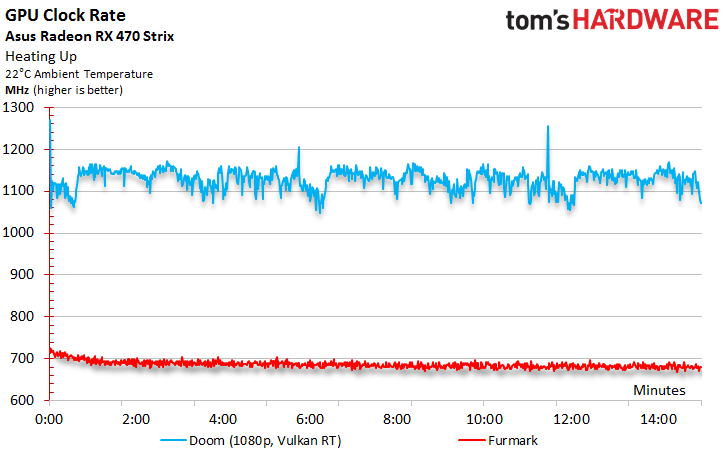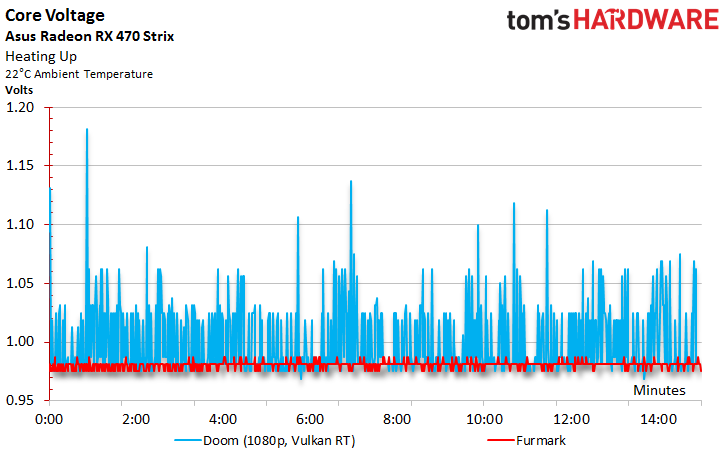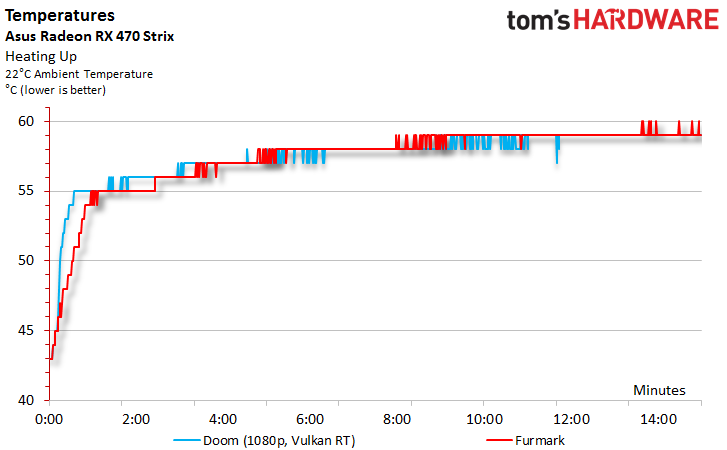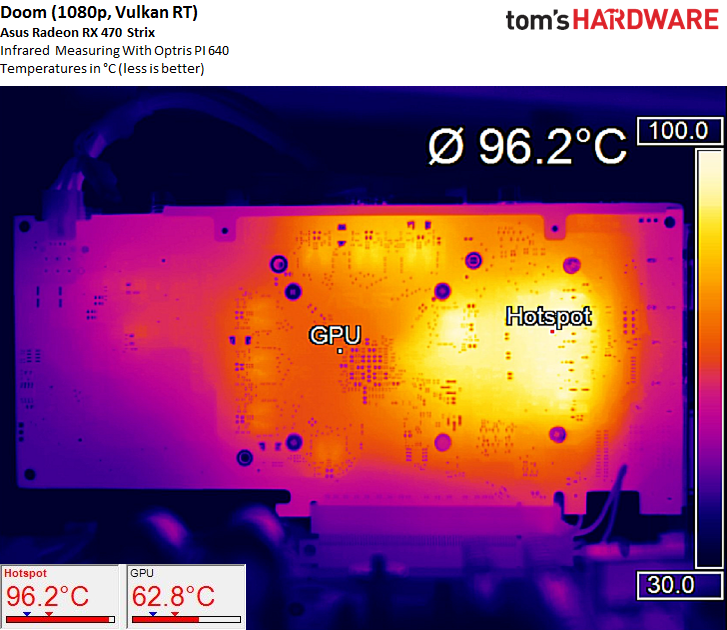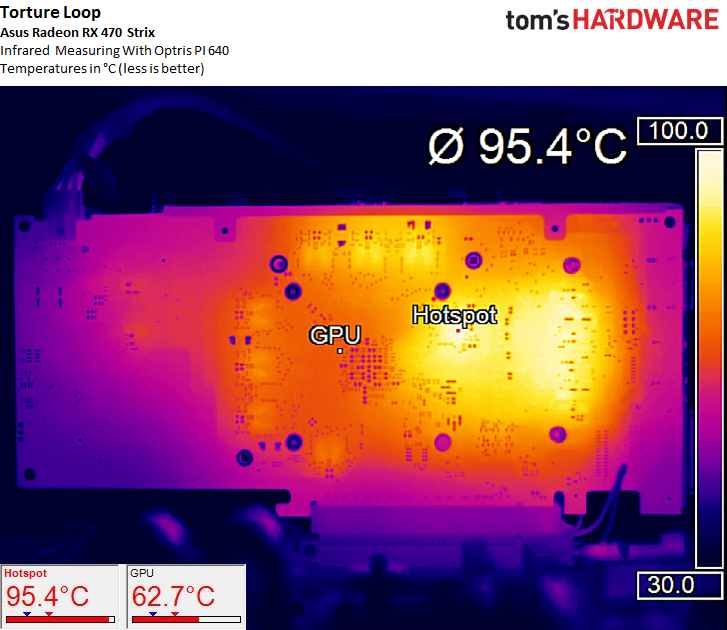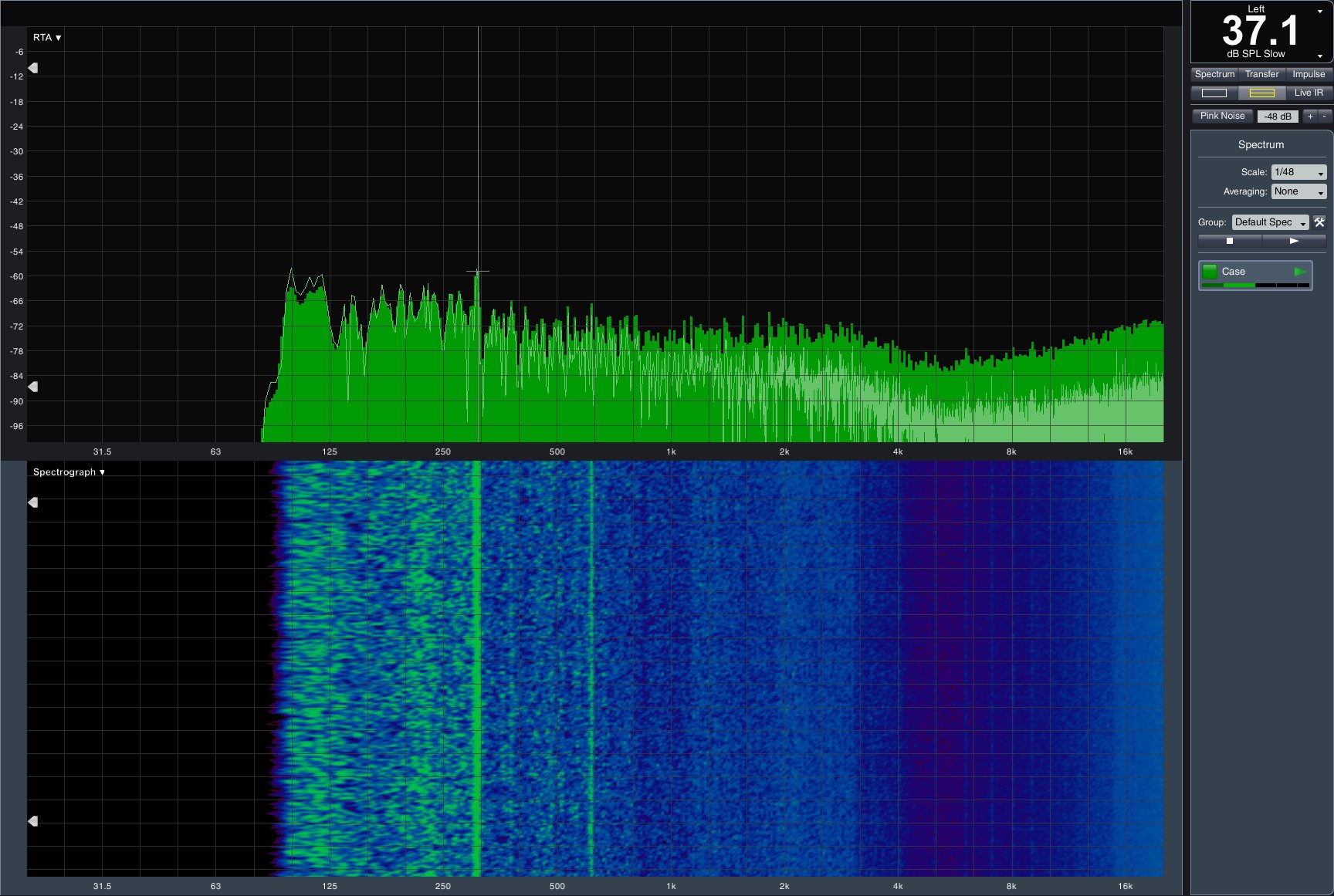AMD Radeon RX 470 4GB Review
Frequency, Temperature & Noise
GPU Boost Clock Rates & Voltages
As a follow-up to the 10-loop Metro: Last Light Redux chart on page two, let's have a look at the Boost clock rates achieved during a test run through Doom. There’s not a whole lot left of the 1270 MHz Asus' card is rated for. The average here was 1150 MHz, including some valleys that bottomed out at 1050 MHz. A very restrictive power limit is to blame, it appears, keeping the card well below a total power consumption of 150W, regardless of the test we ran.
The clock rate fluctuations are ultimately meant to conserve power, and in that context it's also a good idea to take a closer look at the voltages too. We’ve never seen a graphics card switch GPU voltage back and forth this much.
During our stress test, the voltage continuously runs up against its limit. Meanwhile, during a much more dynamic gaming benchmark, it fluctuates between 1.18 and 0.975V.
Temperatures
Asus' cooling performance takes the Strix RX 470 to a final temperature of 59°C during the gaming loop and occasionally up to 60°C during our stress test. In a closed PC case, those numbers change to 61 and 63°C. Our only complaint involves the way the fans jump into action, which we'll explore shortly.
We're using a "clean" scene in Doom, which is to say it no longer contains demons that could kill us, in conjunction with a scripted path via a keyboard macro.
The GPU’s outside temperature, as measured below the package, is similar to what its diode tells us about the state of affairs inside the die. However, the board’s temperature is hotter than the processor as a result of the Strix RX 470's enormous hot spots. Think back to the tight grouping of high- and low-side MOSFETs, along with their tiny cooler, and it's pretty clear where this problem comes from.
Many copper tracks running from the voltage converters to the GPU make for perfect heat pipes. Unfortunately, that turns out badly for one of the memory modules sitting right between the voltage converters and GPU. Temperatures hit 96°C right there, which we have to imagine exceeds the component's specified limits.
Get Tom's Hardware's best news and in-depth reviews, straight to your inbox.
During our stress test, the GPU’s four voltage converters hit almost 94°C. The memory module ends up at a toasty 95°C.
Fan Curves & Noise
We already mentioned the weird fan curve. Its shape just doesn’t make any sense. What starts as a semi-passive mode doesn’t ramp up slowly after starting the fans with a quick pulse. Instead, the Strix RX 470's fans jump to a massive 1150 RPM, go on to hit 1400 RPM a short time later, and then level off at 1350 RPM.
Frankly, a high fan speed might just be the price to pay for relatively low maximum temperatures. Then again, fan blades spinning quickly generate a lot of air turbulence, which gets us wondering what this card's acoustic profile looks like.
As usual, the noise measurements are performed using our silent water-cooled PC in our sound-dampened anechoic chamber built for just this purpose. The setup's practical lower limit is 22 dB(A) due to the measurement system's hardware.
| Test System and Hardware | |
|---|---|
| Microphone | NTI Audio M2211 (with Calibration File, Low Cut at 50 Hz) |
| Amplifier | Steinberg UR12 (with Phantom Power for Microphones) |
| System | Graphics Card Test System with Optimized Water Cooling - Intel Core i7-5930K @ 4.2GHz, Water-Cooled - Crucial Ballistix Sport, 4x 4GB DDR4-2400 - MSI X99S XPower AC - 1x Crucial MX200, 500GB SSD (System) - 1x Corsair Force LS, 960GB SSD (Applications, Data) - be quiet! Dark Power Pro, 850W Power Supply Unit (PSU) |
| Water Cooling | - Alphacool VPP655 Pump (Undervolted) - Alphacool NexXxos CPU Cooler- Phobya Balancer - Alphacool 24cm Radiator - 2x 12cm Noiseblocker eLoop Fan @ 400 RPM |
| Software | Smaart v.7 |
| Measurement Chamber | Custom-Made Proprietary Measurement Chamber, 3.5 x 1.8 x 2.2m (LxDxH) |
| Measurement Position | Perpendicular to Center of Noise Source(s), Measurement Distance of 50cm |
| Measurement Data | - Noise Level in dB(A) (Slow), Real-time Frequency Analyzer (RTA) - Graphical Frequency Spectrum of Noise |
A result of 37.1 dB(A) is fairly high compared to many similar graphics cards. Fortunately, the Strix RX 470's acoustic output spans the entire spectrum and doesn’t include a lot of gear or motor noises. The voltage converters don’t really make their presence known either. Then again, that could be due to the cooling fan's noise drowning out other sounds.
Dialing in your own custom fan curve is one way around our findings. Preferably, it'd result in a lot less noise at lower temperatures. Asus might want to tune its current offering a bit, since there’s definitely room for optimization. This would provide a huge benefit in situations with a partial GPU load. After playing a Blu-ray disc for just one minute, the fan noise already asserts itself in a very noticeable manner. The experience with several monitors is similar. This isn’t just annoying, but also completely unnecessary.
MORE: Best Graphics Cards
MORE: Desktop GPU Performance Hierarchy Table
MORE: All Graphics Content
Current page: Frequency, Temperature & Noise
Prev Page Power Consumption Next Page Pros, Cons & Verdict-
n0ns3ns3 Well ...Reply
Until I see at least 5 games on Vulcan and 10 on DX12 of different types, I'll not jump into conclusion about AMD vs Nvidia performance.
So far the clear winners for AMD are the games sponsored by AMD - so couldn't care less about those results.
Doom is interesting, but any card getting very decent FPS in it. -
FormatC Cool down.... I've just re-published all galleries and the charts are visible now. The US guys are sleeping but I saw the issue (a follow of your new front-end) and fixed it.Reply
Please reload the pages again :) -
Stardude82 Where are the cards? Not seeing them at the big e-retailers.Reply
Edit: Just went live and they're gone. -
Sizzor The MSRP was $149 and looking at the current market the price should be around $180, $200 is way to high for this card.Reply
